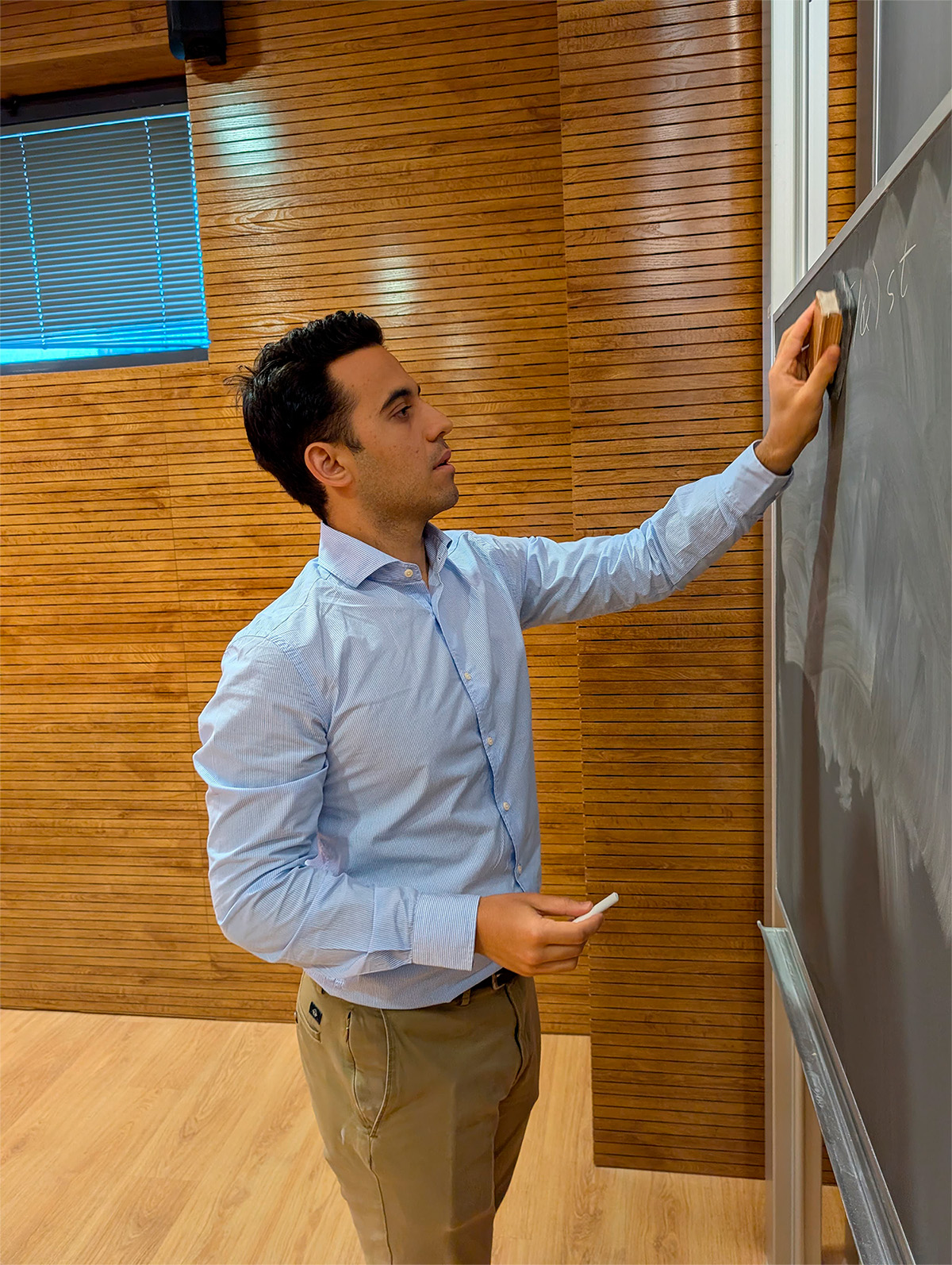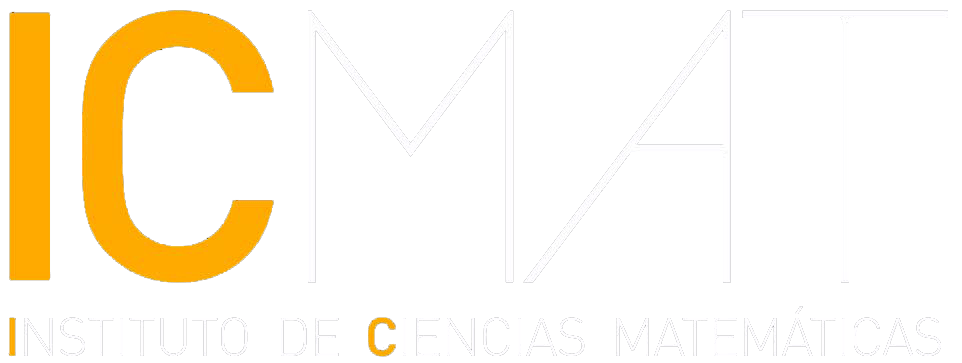The “la Caixa” Foundation has awarded 105 new doctoral and postdoctoral fellowships within its INPhINIT 2024 and Junior Leader 2024 programmes—65 and 40, respectively—six of which have been granted to individuals in the field of theoretical physics and mathematics. Among them are José Antonio Castro Moreno and Pablo Alberto Alvarado Seguel, who will carry out their doctoral studies at ICMAT over the next four years.
Castro chose his thesis topic, fascinated by the use of elliptic curves and modular forms to solve Diophantine equations, as Andrew Wiles did to prove the famous Fermat’s Last Theorem. For his part, Alvarado Seguel turned from physics to mathematics, attracted by the mathematical structures that support physical theories. The area in which his thesis is framed, complex geometry, will allow him to combine his two interests: physics and mathematics.
The fellowships award ceremony took place last Tuesday, 18 March, at the CosmoCaixa Science Museum in Barcelona.
Laura M. Iraola (ICMAT)
Meet the ICMAT Fellows
José Antonio Castro Moreno, “la Caixa” INPhINIT 2024 fellowship
José Antonio Castro Moreno (León, 2000) conducts research in the field of number theory. His predoctoral project, “Explicit Approach to Galois Representations of Elliptic Curves,” is supervised by Nuno Barroso de Freitas, a senior scientist at CSIC at ICMAT.
From an early age, Castro Moreno, who grew up in Valladolid, has been interested in mathematics and physics. During his secondary school years, he participated in the Mathematics and Physics Olympiads, reaching the international stage in the latter. From 2018 to 2023, he pursued a Dual Degree in Physics and Mathematics at the University of Valladolid (UVA), during which he was awarded two research initiation scholarships under the supervision of Antonio Campillo (UVA) and Ana Bravo (ICMAT-Autonomous University of Madrid). In 2023, he moved to Barcelona to undertake the Master’s in Advanced Mathematics and Mathematical Engineering, taking courses at both the Polytechnic University of Catalonia and the University of Barcelona.

Castro Moreno will carry out his doctoral research at ICMAT over the next four years. Image courtesy of the researcher
What is your thesis topic? How did you choose it?
At a summer school organised by ICMAT, Nuno Freitas, my current thesis supervisor, taught a course on the connection between elliptic curves and modular forms, which can be used to solve Diophantine equations. This was the method Andrew Wiles used in 1994 to prove Fermat’s Last Theorem, a seemingly simple problem that had remained unsolved since 1637.
Using some of the most abstract mathematical tools to solve such a concrete problem struck me as an unparalleled beauty. My thesis focuses on studying elliptic curves with the aim of applying this method to other equations.
Why at ICMAT?
Besides the fact that Freitas is a researcher at ICMAT, the Institute offers a very stimulating environment. For me, interacting with people is essential to improving as a mathematician and continuing to progress.
Why did you choose to pursue a PhD?
When I finished my degree, I was completely fascinated by everything I had learned and everything left to learn. Moreover, the idea of discovering something entirely new was immensely appealing.
What milestone would you like to achieve as a professional mathematician?
I believe my role as a mathematician is twofold: on one hand, advancing my field with new results, and on the other, passing on this knowledge to students. I would love to combine both aspects—leading a research group tackling important problems in number theory while supervising many PhD students.
I would love to work at the University of Valladolid in the future, as a way of giving back everything my professors in the city have given and taught me. In fact, I am already collaborating there, as I am part of the committee for the local stage of the Valladolid Physics Olympiad, which I greatly enjoy.
When did you start enjoying mathematics?
I think it was my father who instilled in me a curiosity to understand the world, which, in many cases, involves understanding mathematics. Later, in secondary school, I was fortunate to have teachers who nurtured my interest, such as Carmen Galván and María Jesús Rodríguez, to whom I am very grateful.
Was there anything specific that led you to choose this discipline?
I started university more interested in physics than in mathematics, but gradually, I fell in love with mathematics. The turning point was the Galois Theory course in my third year, taught by Antonio Campillo. Both the course content and Antonio’s way of presenting it made me decide for good.
Have you had any role models (mathematical or otherwise) throughout your career?
Antonio (Campillo) has been the person who has taught me the most mathematics. During the final years of my degree, we would meet almost every week for coffee and discussion. However, I think what has inspired and motivated me most in my career has been interacting with my peers; facing problems together and sharing ideas is incredibly stimulating. I enjoy mathematics even more thanks to Gonzalo Rodríguez, Raquel Melgar, Alejandro Merino, and María de Leyva.
In your free time, what do you like to do?
I used to play inline hockey for the team in Valladolid, and although I stopped some time ago, I still love roller-skating. I am also fascinated by marine life and the sea in general, so whenever I go to the beach in summer, I do snorkelling. A few years ago, I also took a scuba diving course.
What book, film, or album would you recommend?
I would recommend C. Tangana’s first album, “AGZ presenta a C. Tangana.” It is very different from his latest work, but I think it is worth listening to.
INPhINIT & Junior Leader “la Caixa” Fellowships
The fellowships are awarded annually to outstanding researchers to carry out research projects at universities or research centres in Spain and Portugal. Thus, the organisation “aims to both retain and attract talent to promote research excellence in these countries.”
—
This content has been automatically translated. The original text may differ slightly
